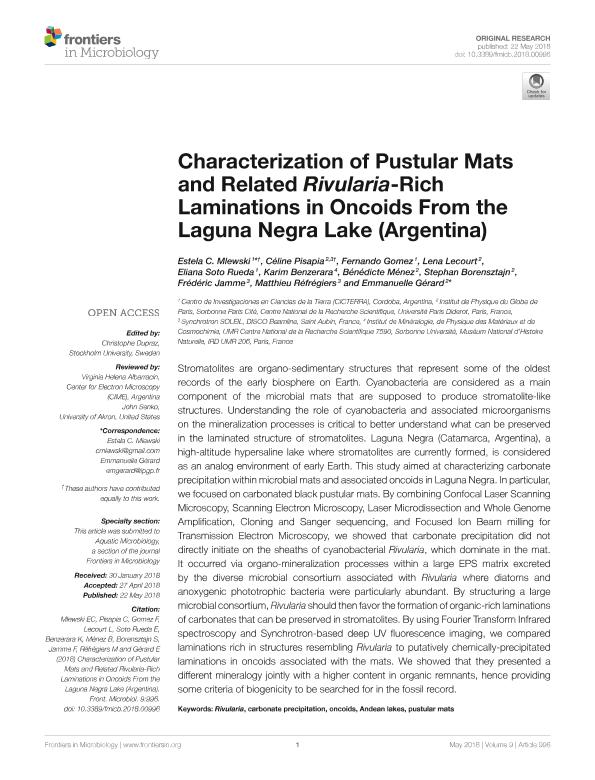Mostrar el registro sencillo del ítem
dc.contributor.author
Mlewski, Estela Cecilia

dc.contributor.author
Pisapia, Céline
dc.contributor.author
Gomez, Fernando
dc.contributor.author
Lecourt, Lena
dc.contributor.author
Soto Rueda, Eliana Marcela

dc.contributor.author
Benzerara, Karim
dc.contributor.author
Ménez, Bénédicte
dc.contributor.author
Borensztajn, Stephan
dc.contributor.author
Jamme, Frédéric
dc.contributor.author
Réfrégiers, Matthieu
dc.contributor.author
Gérard, Emmanuelle
dc.date.available
2019-11-13T15:46:49Z
dc.date.issued
2018-05
dc.identifier.citation
Mlewski, Estela Cecilia; Pisapia, Céline; Gomez, Fernando; Lecourt, Lena; Soto Rueda, Eliana Marcela; et al.; Characterization of pustular mats and related Rivularia-rich laminations in oncoids from the Laguna Negra lake (Argentina); Frontiers Media S.A.; Frontiers in Microbiology; 9; MAY; 5-2018
dc.identifier.uri
http://hdl.handle.net/11336/88725
dc.description.abstract
Stromatolites are organo-sedimentary structures that represent some of the oldest records of the early biosphere on Earth. Cyanobacteria are considered as a main component of the microbial mats that are supposed to produce stromatolite-like structures. Understanding the role of cyanobacteria and associated microorganisms on the mineralization processes is critical to better understand what can be preserved in the laminated structure of stromatolites. Laguna Negra (Catamarca, Argentina), a high-altitude hypersaline lake where stromatolites are currently formed, is considered as an analog environment of early Earth. This study aimed at characterizing carbonate precipitation withinmicrobialmats and associated oncoids in Laguna Negra. In particular, we focused on carbonated black pustular mats. By combining Confocal Laser Scanning Microscopy, Scanning Electron Microscopy, Laser Microdissection and Whole Genome Amplification, Cloning and Sanger sequencing, and Focused Ion Beam milling for Transmission Electron Microscopy, we showed that carbonate precipitation did not directly initiate on the sheaths of cyanobacterial Rivularia, which dominate in the mat. It occurred via organo-mineralization processes within a large EPS matrix excreted by the diverse microbial consortium associated with Rivularia where diatoms and anoxygenic phototrophic bacteria were particularly abundant. By structuring a large microbial consortium, Rivularia should then favor the formation of organic-rich laminations of carbonates that can be preserved in stromatolites. By using Fourier Transform Infrared spectroscopy and Synchrotron-based deep UV fluorescence imaging, we compared laminations rich in structures resembling Rivularia to putatively chemically-precipitated laminations in oncoids associated with the mats. We showed that they presented a different mineralogy jointly with a higher content in organic remnants, hence providing some criteria of biogenicity to be searched for in the fossil record.
dc.format
application/pdf
dc.language.iso
eng
dc.publisher
Frontiers Media S.A.
dc.rights
info:eu-repo/semantics/openAccess
dc.rights.uri
https://creativecommons.org/licenses/by-nc-sa/2.5/ar/
dc.subject
ANDEAN LAKES
dc.subject
CARBONATE PRECIPITATION
dc.subject
ONCOIDS
dc.subject
PUSTULAR MATS
dc.subject
RIVULARIA
dc.subject.classification
Geología

dc.subject.classification
Ciencias de la Tierra y relacionadas con el Medio Ambiente

dc.subject.classification
CIENCIAS NATURALES Y EXACTAS

dc.title
Characterization of pustular mats and related Rivularia-rich laminations in oncoids from the Laguna Negra lake (Argentina)
dc.type
info:eu-repo/semantics/article
dc.type
info:ar-repo/semantics/artículo
dc.type
info:eu-repo/semantics/publishedVersion
dc.date.updated
2019-10-23T20:54:20Z
dc.identifier.eissn
1664-302X
dc.journal.volume
9
dc.journal.number
MAY
dc.journal.pais
Suiza

dc.journal.ciudad
Lausanne
dc.description.fil
Fil: Mlewski, Estela Cecilia. Consejo Nacional de Investigaciones Científicas y Técnicas. Centro Científico Tecnológico Conicet - Córdoba. Centro de Investigaciones en Ciencias de la Tierra. Universidad Nacional de Córdoba. Facultad de Ciencias Exactas Físicas y Naturales. Centro de Investigaciones en Ciencias de la Tierra; Argentina
dc.description.fil
Fil: Pisapia, Céline. Institut de Physique Du Globe de Paris; Francia
dc.description.fil
Fil: Gomez, Fernando. Consejo Nacional de Investigaciones Científicas y Técnicas. Centro Científico Tecnológico Conicet - Córdoba. Centro de Investigaciones en Ciencias de la Tierra. Universidad Nacional de Córdoba. Facultad de Ciencias Exactas Físicas y Naturales. Centro de Investigaciones en Ciencias de la Tierra; Argentina
dc.description.fil
Fil: Lecourt, Lena. Université Paris Diderot - Paris 7; Francia
dc.description.fil
Fil: Soto Rueda, Eliana Marcela. Consejo Nacional de Investigaciones Científicas y Técnicas. Centro Científico Tecnológico Conicet - Córdoba. Centro de Investigaciones en Ciencias de la Tierra. Universidad Nacional de Córdoba. Facultad de Ciencias Exactas Físicas y Naturales. Centro de Investigaciones en Ciencias de la Tierra; Argentina
dc.description.fil
Fil: Benzerara, Karim. Sorbonne Université. Muséum National d'Histoire Naturelle; Francia. Centre National de la Recherche Scientifique; Francia
dc.description.fil
Fil: Ménez, Bénédicte. Institut de Physique Du Globe de Paris; Francia
dc.description.fil
Fil: Borensztajn, Stephan. Institut de Physique Du Globe de Paris; Francia
dc.description.fil
Fil: Jamme, Frédéric. Synchrotron Soleil ; Francia
dc.description.fil
Fil: Réfrégiers, Matthieu. Synchrotron Soleil ; Francia
dc.description.fil
Fil: Gérard, Emmanuelle. Institut de Physique Du Globe de Paris; Francia
dc.journal.title
Frontiers in Microbiology
dc.relation.alternativeid
info:eu-repo/semantics/altIdentifier/url/https://www.frontiersin.org/article/10.3389/fmicb.2018.00996/full
dc.relation.alternativeid
info:eu-repo/semantics/altIdentifier/doi/http://dx.doi.org/10.3389/fmicb.2018.00996
Archivos asociados
